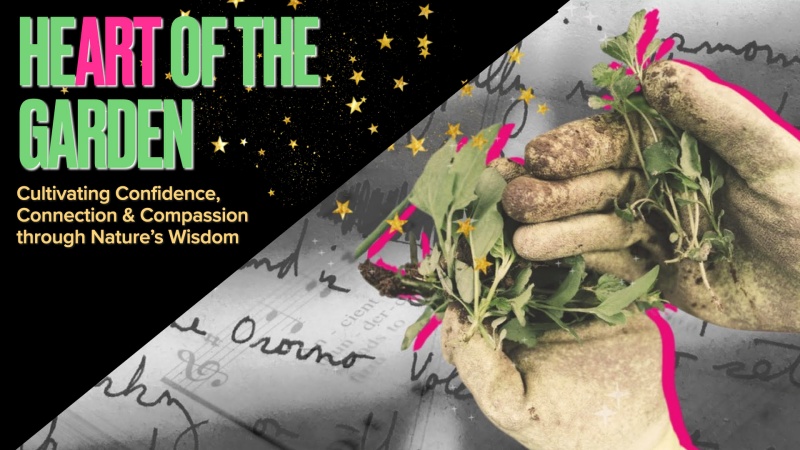2024 Benicia & Vallejo Demonstration Food Forest Garden Tour: April 27
By Nicole Newell, Sustainable Landscaping Program Manager
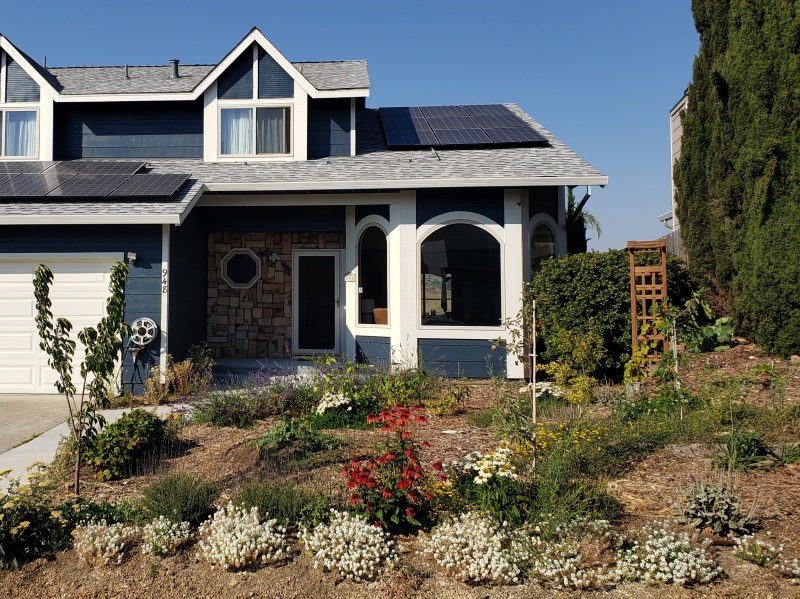
Loam Sweet Loam garden in Vallejo
Sustainable Solano’s annual tour of demonstration food forest gardens in Benicia and Vallejo returns on April 27 for its eighth year. Join us for our largest tour of some of the longest-established food forests in the county!
The day will include speakers and activities to keep you inspired and engaged. Register here!
We will start at 9 am at Avant Garden in Benicia with a talk about the many roles mulch plays in supporting a water-efficient garden with Heath Griffith from Grow with the Flow. Learn about:
- What is the difference between wood chips and bark?
- Why is mulch one of the superheroes of permaculture?
- Does mulch increase or decrease fire risk around houses?
- How does mulch support a water-efficient garden?
Attendees will pick up the itineraries from 9-11 am at Avant Garden for a self-guided tour of the Benicia and Vallejo gardens. This year’s tour will continue to provide education on topics related to sustainability and highlight the amazing organizations and ways people are involved in uplifting the community. In addition to education, we will also have music, an adventurous scavenger hunt for our youth, two inspired gardens and a special guest that will be present to chat about calming calendula.
The Benicia gardens will be open from 10 am-1 pm, and the Vallejo gardens will be open from 1-4 pm. Attendees who can only participate in the afternoon can pick up the itineraries for Vallejo at the Pollinator Pathway garden on Mare Island from 12-1 pm.
You can learn about each garden and the special events going on at the gardens here.
To prepare a garden tour event that is in service to our community is a gift. As I learn what inspires our food forest keepers to live, grow and contribute, I am inspired in return. Spring brings new possibilities to discover what seeds we want to plant, in our garden and in our life. Each garden serves so many functions that support an abundant, healthy life. I invite you to explore these gardens and gain your own inspiration for your gardens, your communities and your lives.
This program is made possible by the generous support from the Solano County Water Agency.
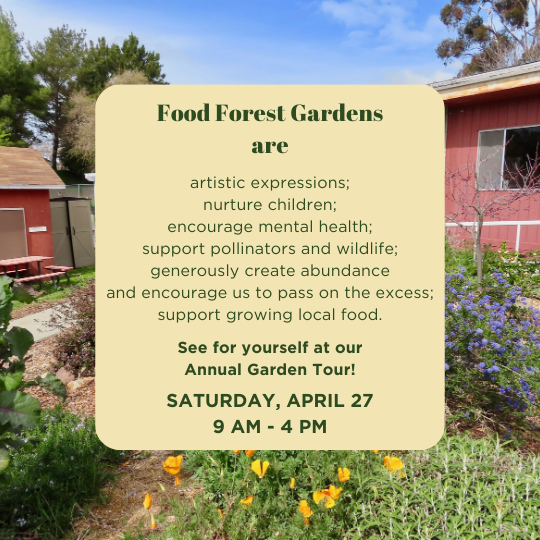
Plan Your Day
How It Will Work
You can choose to tour for the whole day or for half a day.
Benicia Demonstration Food Forest Gardens will be open 10 am-1 pm
Vallejo Demonstration Food Forest Gardens will be open 1-4 pm
Itinerary pickup and special events:
9-11 am: Itineraries will be available at Avant Garden in Benicia (400 First St.). This itinerary will include all of the demonstration food forest gardens in Benicia (open in the morning) and Vallejo (open in the afternoon). Families can pick up a scavenger hunt sheet that will make the day more fun!
9 am: Heath Griffith of Grow with the Flow will talk about the importance of mulch at Avant Garden.
12-1 pm: Itineraries for the Vallejo garden sites (open in the afternoon) will be available at the Global Center for Success (1055 Azuar Dr/BLDG 733).
Throughout the day: Special speakers, activities and information will be available at various gardens.

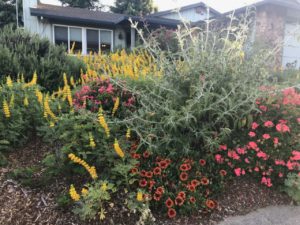 Mature front yard food forest has mostly fruit trees and native plants that attract pollinators year-round. It has a laundry-to-landscape greywater system.
Mature front yard food forest has mostly fruit trees and native plants that attract pollinators year-round. It has a laundry-to-landscape greywater system.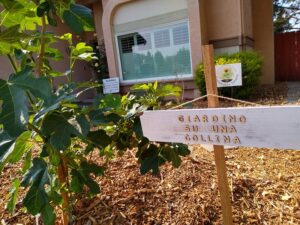 A 4-year-old food forest and pollinator garden installed in 2020 that includes a swale that captures roof water and mediterranean trees and plants mixed with native pollinating and nectar plants to attract bees and butterflies. This site is home to a Monarch Waystation that grows a variety of plants to support Western Monarch Butterflies.
A 4-year-old food forest and pollinator garden installed in 2020 that includes a swale that captures roof water and mediterranean trees and plants mixed with native pollinating and nectar plants to attract bees and butterflies. This site is home to a Monarch Waystation that grows a variety of plants to support Western Monarch Butterflies.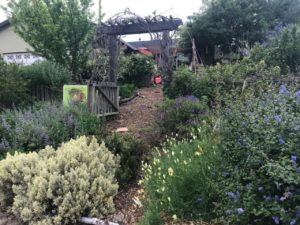 A 9-year-old established food forest with two swales that are dug out and refreshed every 2-3 years, laundry-to-landscape greywater to fruit trees, and chickens. The drip irrigation system was removed four years ago and the garden is thriving! Annual beds are hand-watered once a week during the growing season. Greyhawk Grove is a “high-traffic-survival-of-the-fittest-have-three-young-children garden”. There may be lemonade and baked goods for sale by children, as well as products from the garden to give away (dried calendula, lavender, herbs, eggs, fruit, etc.).
A 9-year-old established food forest with two swales that are dug out and refreshed every 2-3 years, laundry-to-landscape greywater to fruit trees, and chickens. The drip irrigation system was removed four years ago and the garden is thriving! Annual beds are hand-watered once a week during the growing season. Greyhawk Grove is a “high-traffic-survival-of-the-fittest-have-three-young-children garden”. There may be lemonade and baked goods for sale by children, as well as products from the garden to give away (dried calendula, lavender, herbs, eggs, fruit, etc.).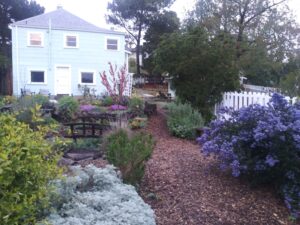 Southern slope food forest focused on pollinators, shrubs and native plants. It also includes fruit trees, perennial and edible plants, swales and a laundry-to-landscape greywater system.
Southern slope food forest focused on pollinators, shrubs and native plants. It also includes fruit trees, perennial and edible plants, swales and a laundry-to-landscape greywater system.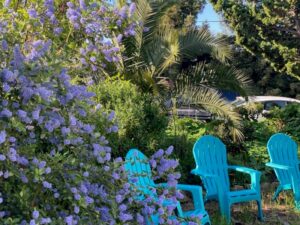 An evolving food forest garden and greywater system installed as part of Sustainable Solano’s 2022-23
An evolving food forest garden and greywater system installed as part of Sustainable Solano’s 2022-23 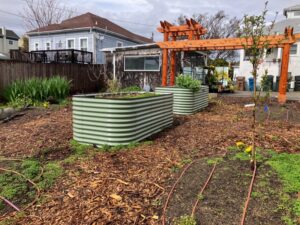 This homeowner attended our tours and was inspired to transform his yard! This garden, designed by Michael Wedgley of
This homeowner attended our tours and was inspired to transform his yard! This garden, designed by Michael Wedgley of 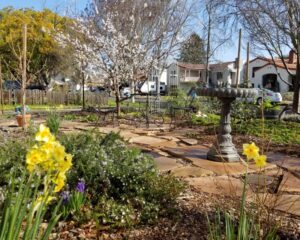 This front yard lawn was replaced in
This front yard lawn was replaced in 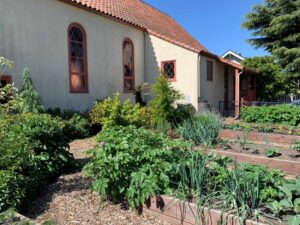 Two separate gardens, one is a peace garden with mostly flowers, cactus and trees and the other is the vegetable garden, called Johnson Ranch. The vegetable garden was revived through the
Two separate gardens, one is a peace garden with mostly flowers, cactus and trees and the other is the vegetable garden, called Johnson Ranch. The vegetable garden was revived through the 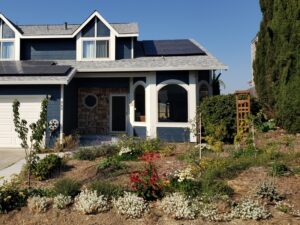
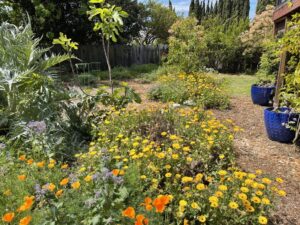 Morningside Botanical Bounty food forest was created as part of the
Morningside Botanical Bounty food forest was created as part of the 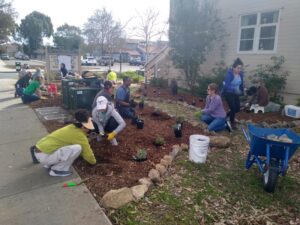 Pollinator food forest garden filled with a variety of California native plants that support the habitat of butterflies, bees, moths, wasps, hummingbirds and so much more. This garden was installed in February 2023 as a collaboration with a variety of organizations including Vallejo People’s Garden, Vallejo Project, Solano Resource Conservation District and Monarch Milkweed Project. Alanna Mirror wrote three songs inspired by the installation, featured in her
Pollinator food forest garden filled with a variety of California native plants that support the habitat of butterflies, bees, moths, wasps, hummingbirds and so much more. This garden was installed in February 2023 as a collaboration with a variety of organizations including Vallejo People’s Garden, Vallejo Project, Solano Resource Conservation District and Monarch Milkweed Project. Alanna Mirror wrote three songs inspired by the installation, featured in her 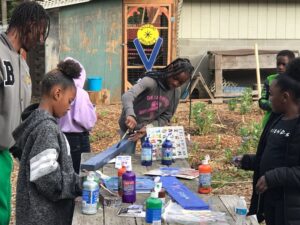 Vallejo Project’s Unity Garden initiative restored an abandoned lot that was once filled with sand and garbage and turned it into a multi-level food forest with internationally influenced farming techniques, a mealworm farm and chickens. This garden is focused on urban agriculture.
Vallejo Project’s Unity Garden initiative restored an abandoned lot that was once filled with sand and garbage and turned it into a multi-level food forest with internationally influenced farming techniques, a mealworm farm and chickens. This garden is focused on urban agriculture.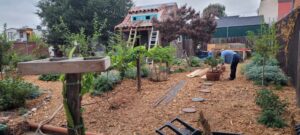

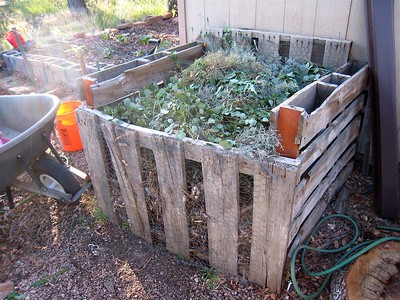 Soil health is a big focus for Sustainable Solano this year. This March through May, we’ll be offering classes for all levels of composting to build healthy soil. This series will consist of three classes, with a beginners composting class in March, an intermediate class in April and an advanced composting class in May. You are invited to attend the class of your choice or join us for all three to build your composting knowledge and connect with the different gardens where each class will be held.
Soil health is a big focus for Sustainable Solano this year. This March through May, we’ll be offering classes for all levels of composting to build healthy soil. This series will consist of three classes, with a beginners composting class in March, an intermediate class in April and an advanced composting class in May. You are invited to attend the class of your choice or join us for all three to build your composting knowledge and connect with the different gardens where each class will be held. Composting 101 will be followed by Intermediate Compost Skills – An Introduction to Worm Composting, also taught by Lori Caldwell. This class will go over compost mishaps and how to troubleshoot bin repair, pests, etc. The time will also be used to introduce worm composting, discussing the benefits of worms, worm castings, and this compost method that is very friendly for those who want to compost but have less space to work with. The Vallejo Project Unity Garden will be hosting this class, with a worm bin and a three-bin compost system that has been paused due to pest issues and repair needs. This class will be interactive and potentially hands on, as we hope to show examples of bin repairs and give their compost system a bit of TLC.
Composting 101 will be followed by Intermediate Compost Skills – An Introduction to Worm Composting, also taught by Lori Caldwell. This class will go over compost mishaps and how to troubleshoot bin repair, pests, etc. The time will also be used to introduce worm composting, discussing the benefits of worms, worm castings, and this compost method that is very friendly for those who want to compost but have less space to work with. The Vallejo Project Unity Garden will be hosting this class, with a worm bin and a three-bin compost system that has been paused due to pest issues and repair needs. This class will be interactive and potentially hands on, as we hope to show examples of bin repairs and give their compost system a bit of TLC.